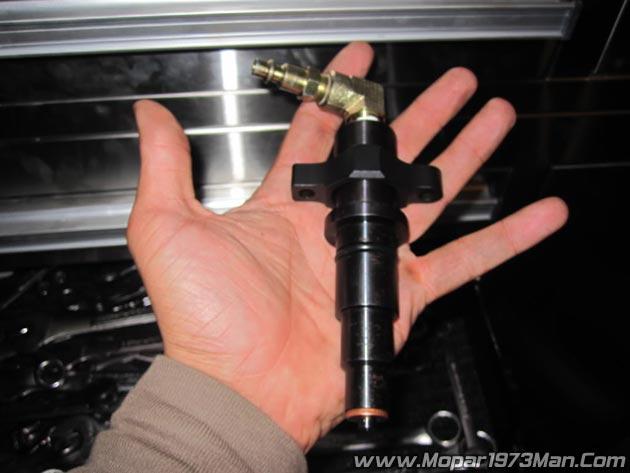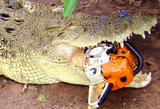Compression Test
As promised. I forgot to take pictures yesterday when I did this, plus I did it a slightly different way than the way I am going to explain. My gauge I have had for years, I drilled the check valve out WAY bigger than when it came from snap on. This way, I can do a check without the rockers on...... Anyway.
You will need to get your hands on.
1. A compression test gauge suitable for a diesel engine's high compression. I have a snap-on MT 33 B, as well as a C model. Both are good for 800 PSI. And use standard 1/4" snap in quick connect air tool fitting.
2. A compression test adapter. Looks like an injector and fits where the injector goes. For the ISB (98-2007 in Dodge's) you can use either the Snap On Adapter: Stock#: EEPV313A or the Miller Tools # 9007. About 100 bucks for the snap on and 160 for the Miller.
MT33B:

Snap on adapter:

Miller Tools adapter:

Both are good quality and use the same 1/4" snap-in style fitting. However, with the 98-02 motors you are going to have to remove the exhaust rocker arm to facilitate removal of the injector hold down shoulder bolt, which I will detail later. If you get the snap on adapter, you do not have to do this step on the 98-02 Dodge motors.
First thing you are going to want to do before you forget, like I do EVERYTIME!!! is to:
1. Disconnect power from the fuel lift pump.
2. Might as well remove the injector pump relay from the PDC box.
Now you can get down to it...
1. Follow Mopar1973Man's directions for replacing the fuel injectors. [Remove the high pressure fuel lines, valve cover, intake, etc etc. You are wanting to get down to having no injectors in the motor at all] If you have a common rail motor or have a 98-02 and are using the Miller #9007 adapter, keep track of which cylinders your exhaust rockers go to, that way you don't have to worry too much about readjustment of rocker lash after you reinstall them for the compression test.
-Start with cylinder number 1.
-Stuff a rag down into the injector bores like I can never seem to remember to do!!!!
2. If you have a 98-02, remove the 10MM head flange bolt from the rocker pin of the exhaust rocker lever. Carefully lift the rocker lever off the pedestal, being careful not to let the pin slide out. If you have a common rail, your exhaust rocker lever is already off to have the injectors removed!! On the 98-02's you have to remove the exhaust rocker and are using the miller gauge because of this! Can't access the back bolt with that rocker on there. Why you gotta pull that rocker to pull the injectors on a common rail.

3. Remove the 8MM head injector hold down shoulder bolt from cylinder 1 if you are using the Miller Tools adapter #9007 and have a 98-02. If using snap on, please skip step 2 and step 3 on the 98-02 motors. On common rail, you will already have the exhaust rocker off, so just take your 2 8mm bolts and bolt the adapter down.

4. Inspect injector bore for debris, if any is present, clean it out!
5. Stick the compression test adapter down into the injector bore being mindful to the direction of the snap in style quick connect fitting is pointing.
6. FOR MILLER TOOLS 9007 ONLY: Take another regular 8MM head injector hold-down bolt from one of your other cylinders and use it in concert with the regular hold down bolt to bolt down your compression test adapter fitting into the injector bore.
(these are just the full thread bolts that you remove when you pull your injectors, 6 of them on a 98-02 and 12 of them on a common rail.
7. Reinstall the exhaust rocker for number 1. Ensuring that you have not screwed around with the adjuster nut for the valve lash and that you used the proper rocker arm you removed from that cylinder, it should be ok as is.
8. Hook er up.

9. Ensure that everything has been removed from the high pressure fuel system-feed lines, fuel pump is not powered up!!!, relay is removed from PDC, and you are absolutely certain your valve lash is set properly and the 10MM head rocker lever hold down bolts are TIGHT (YOU DONT WANT TO SCREW THAT UP AND HAVE IT WHERE A PISTON CAN SLAP A VALVE, THAT WILL BEND PUSHRODS!)
10. Bump the motor over for about 10 seconds, and record that compression reading on a piece of paper.
Do this for the rest of the cylinders.
No published numbers for the compression specs. Lot of variables come into play... If you have altered the motor in some way, different pistons in race motors (decompressed) etc, your numbers will be lower. 16.3: 1 motors like the auto tranny motors that are SO, they will be slightly lower than the common rails and the HO 01 and 02 motors that have 17:1 compression ratios. All in all, you are really going to have to look at this on an individual basis..
In general, you are going to want to see at least 375 psi all across the board. In real life, 9/10 when you check a motor that runs good it will be above 400 , 450 500 psi depending on the motor. Shouldn't see too much of a variance between two adjacent cylinders, if you do it is often indicative of a head gasket combustion leak. Normal to do both a leak down and a compression test if you are trying to find a problem.
ALSO. If you don't have the gauge and you have the adapter, you can do what is called a LEAK DOWN TEST. You would just hook up your air compressor to the compression adapter and set it for 100 PSI or so. NOTE: This will only work if you are on the compression stroke (BOTH VALVES CLOSED) and you have some way to hold the motor, like a barring tool for the flywheel!. If you don't, depending on what stroke the cylinder you are testing is at, it will try to spin over when you put the air to it. With this test, you can listen and see if you have a leak and can figure it out by listening. IF you do have a leak, take a oil can with a flexible dispenser straw, small enough to fit down into the injector bore hole, and oil around the edge of the cylinder wall to seal the top keystone ring. Put the air to it, if your leak sound stops, then its your rings. If it doesn't then you got something else wrong and probably need to pull the head.
After you are done, hook everything back up and get er' done.



There are no reviews to display.